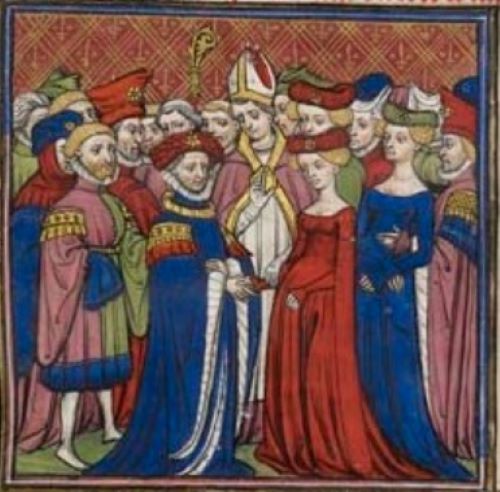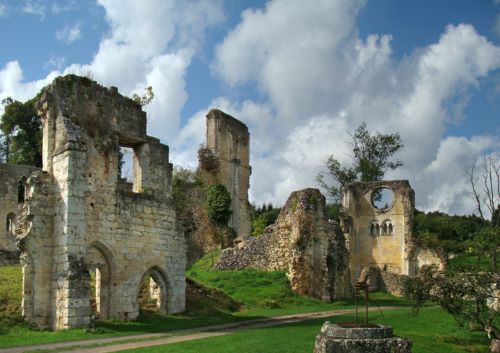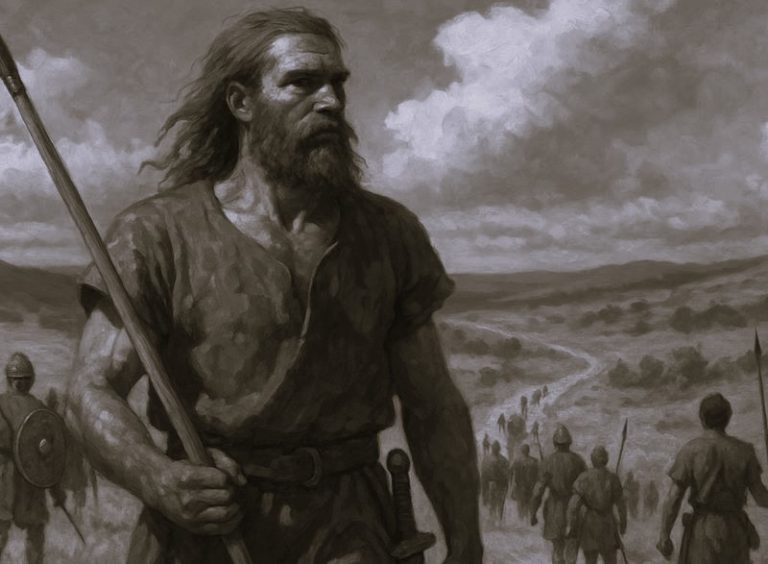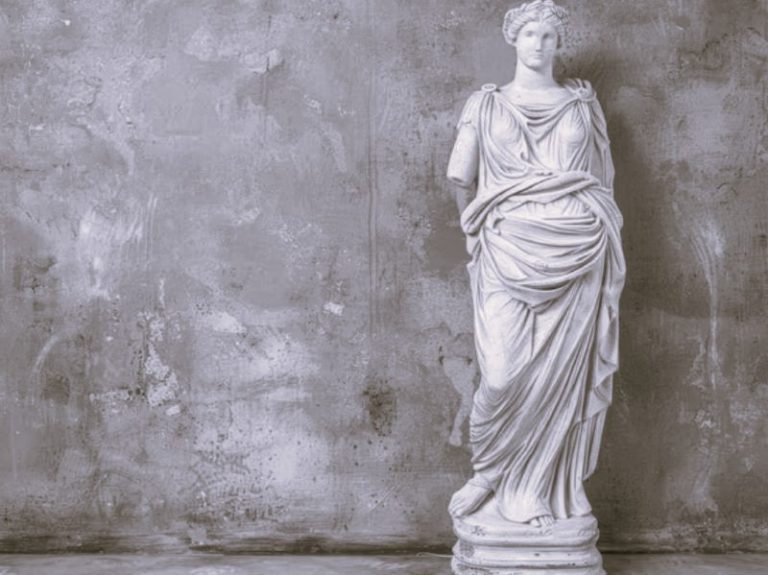

The display and gifting of artefacts were crucial when aiming to impact others.

By Dr. Jitske Jasperse
Ramón y Cajal Researcher
Consejo Superior de Investigaciones Científicas (CSIC)
Introduction
Medieval marriage gifts of landholdings, both from dowry—property given with the bride by her natal family—and dower—property handed over to the bride by her husband—have primarily occupied historians due to the struggles over territories that resulted from marital alliances.1 While all sisters received dower lands from their husbands, Henry II and Eleanor endowed neither Matilda nor the youngest sister Joanna (1165–1199) with dowry.2 It would not have made much sense for King Henry II to give his eldest daughter part of his or his wife’s lands, as her future husband’s territories were too far away from those held by the English king. The same argument can be made for Joanna when in 1177 she married King William II of Sicily. Whether Matilda’s younger sister Leonor (1161–1214) was given Gascony as dowry when she married Alfonso VIII, king of Castile, is debated among historians, since no English records make mention of such a grant.3 While Alfonso certainly went to great lengths to claim Eleanor of Aquitaine’s land, it was never successfully consolidated in his kingdom. The absence of dowry was compensated for by the auxilium—payments made by his subjects, in this case to facilitate the marriage—Henry II raised:Matilda brought £5,102 sterling to Saxony, a sum higher than the £4,549 he would later collect for Joanna’s marriage in 1177. Matilda’s auxilium matched that of the money spent by her great-grandfather King Henry Ion the occasion of his daughter Matilda’s engagement to the German king (and later emperor) Henry V, who received 10,000 Cologne marks of silver, which corresponds to £5,000.4 Even though no similar large sums of money are documented for Leonor, it is only reasonable to assume that she brought a substantial sum of silver into her marriage with Alfonso.
In addition to the silver, Matilda was accompanied by many treasures that are examined here to demonstrate the ongoing importance of artefacts in marriage politics.5 These treasures included gold, silver, vessels, vestments, chairs, saddles, and many other items. By asking how such pieces reflected the royal status of Matilda’s natal family and added to the creation of her social identity, Matilda’s sumptuous goods can be understood as a first step in the performance of power of royal daughters. To this end, comparisons are made with moveable objects that can be connected to her paternal grandmother Empress Matilda (d. 1167) and to the younger Matilda’s sisters in the context of their respective marriages. In a way, Princess Matilda followed in the footsteps of her eponymous grandmother, who as an eight-year-old had journeyed to Germanic lands to meet her future husband, King Henry V (d. 1125). Matilda’s sister Leonor went to Iberia to become the wife of King Alfonso VIII of Castile (d. 1214) while Joanna was to marry first King William II of Sicily (d. 1189) and later Count Raymond VI of Toulouse (d. 1222).

Matilda, Leonor, and Joanna were twelve, eight/nine, and eleven respectively when they entered the households of their husbands-to-be. In Colette Bowie’s discussion of the marriages of the three sisters, she traced Leonor’s and Joanna’s travel routes; together with the possible routes Isuggest for Matilda, it is possible to map the way-stations on thejourney of each to her new court (see Map 1).6 Henry II placed his daughters strategically across western Europe, dispersing them as he did other gifts.7 Equally importantly, the young women’s travels demonstrate that their journeys were a vital part of the commu‐nication of the English king’s power.8 Each journey can be seen as a theatrical stage that allowed Henry to promote himself and his daughters through the display of both goods and people, from bishops, counts, and dukes to the princesses’ personal entourage and other relatives. At the same time, this ostentatious representation was a means to reconnect with sometimes estranged allies, and also to acknowledge the high prestige of the future bridegrooms. After all, these marriages were political actions as well as political events, strategically conceived by the English king and his carefully selected sons-in-law. Based on the material, visual, and performative aspects of the sisters’ travels, these journeys should be understood as formative experiences for Henryʼs daughters. They learned that the display and gifting of artefacts were crucial when aiming to impact others. My analysis of the materiality of these objects also shows that the precious items themselves held agency. Here, materiality refers to the materials used to craft the artworks (such as silver, gold, silk, and fur) as well as to the communicative meaning these materials held in the eyes of the beholder. The underlying assumption is that viewers were aware of the history of materials and their symbolic and economic value.9
From England to Saxony
Arrangements for the marriage of Matilda and Henry the Lion, duke of Saxony and Bavaria, commenced in April 1165, when she was nearly nine years old.10 This marriage, like that of her grandmother the Empress Matilda as well as those of her sisters Leonor and Joanna, provided ample opportunity to display the status and wealth of the young princess and her natal family during the long journeys to their new homes. From the entries in the Pipe Rolls, in which expenditures concerning England were recorded, it is possible to distil a general impression of what Matilda brought with her. Between July and September 1167 envoys from Germany had arrived in England to accompany Matilda to Saxony. In September of that year, the princess and her mother travelled from Winchester (?)to Dover, accompanied by Henry the Lion’s and Henry II’s envoys, who took Matilda to Saxony while her mother stayed behind.11 Matilda departed from England in a royal ship (esnecca), accompanied by six other vessels, clearly displaying her royal status.12 The ships brought with them twenty bags (paribus) and twenty chests (cofforum) filled with golden and gilded household utensils (auro ad deauranda vaisella), textiles (pannis), two large silk cloths (magnis pannis sericis), two textile coverings or hangings (tapetis), three Spanish silk cloths (pannis de Musce), and a cloth of samite (a compound twill-weave in silk), as well as seven gilded chairs covered with scarlet and seven gilded saddles. The goods were carried by thirty-four pack mules (sumar) to be loaded onto the ships.13
From this entry, it is possible to get an idea of the exotic nature of the cloths in Matilda’s holdings, silks that in all likelihood originated from Byzantium and Iberia.14 Introduced by the Muslims, silk production in Spain was booming in the twelfth century and was exported to the rest of Europe, with London as an important centre for the trade of silks and furs. Drap de Mulce frequently appears in French and English romances, and it is possible that pannis de Musce refers to the cloth made in Murcia.15 The sable furs were imported as well. Sable, a Siberian animal of the marten family, has very valuable fur;16 Henry II paid £16 for the twelve sables he gave to Matilda, which is more than he paid for the seven chairs and seven saddles she also brought with her. Sable fur reappears in the Pipe Rolls, indicating that it was held in high regard, with its costliness further underscored when mentioned together with other high-priced items, such as scarlet and silk. The samite cloth, also a silk, is the only piece that provides some insight into its appearance, as it refers to a specific weaving technique.17 Woven fabrics were used for clothing as well as for decorating chambers, widows, and tables. The gilded chairs of Matilda’s dowry were suitable to be covered with cloth, such as scarlet (scarleta or escarlata), which is a fine woollen shaved cloth that was dyed with kermes from the Mediterranean. The use of expensive materials and the combination of the colours red and gold were unlikely to escape the attention of the viewers. Matilda’s cargo also included twelve sable furs (sabilinis), a riding horse (palefrido) and a hunter (fugatore). The palfrey and hunter, for which thirty-seven shillings were paid, are specified as being Matilda’s and were meant for hunting, an event also suitable to display status, wealth, and privileges. Like the silks and distinctly coloured materials, the furs and horses wielded symbolic, economic, and aesthetic agency.

Evidently, King Henry II sent off his daughter with sufficient pomp when he bestowed upon her an impressive variety of textiles, although the Pipe Roll entry lacks references to their colour. Equally, no explicit allusions to the appearance of Matilda’s outfits are made, whereas entries referring to mantles lined with fur (pelliciis) or a large pallium of the finest wool dyed with red kermes and lined with sable fur (pallio magno de escarlata de bissis cum sabellinis) do exist for other members of Henry’s household.18 Visual sources, such as the seal belonging to Matilda’s sister Joanna and a miniature in Henry and Matilda’s psalter demonstrate the presence of fur-lined mantles in the wardrobe of elite men and women. In their psalter, Henry and Matilda are humbly depicted at the foot of Christ’s cross. Henry’s red mantle has slipped from his shoulders, but the grey and white fur collar is still visible. Matilda’s green mantle is trimmed with similar fur, with the grey fur perhaps being vair, which is the grey winter fur of the red squirrel. The highest quality of winter squirrel furs was found in Scandinavia and Russia; they were exported to Western Europe via the Baltic.19 On her seal matrix, Joanna wears the same type of cloak held together by as tassel. With her left hand, Joanna touches this fringed cord that fastens the mantle. The lining of her mantle is prominently displayed and its pattern suggests that it could be miniver; that is, vair furs stitched together so that only the white bellies and some grey around them remained. The small size of vair furs meant that large numbers were needed for lining mantles, making them very costly.20 The colour, texture, and size of furs, whether real or represented, were wrapped around the bodies of men and women to communicate their wearer’s position in society; they signalled wealth, prestige, and fashion.
Sybilla Schröder’s extensive analysis of the material culture mentioned in the Pipe Rolls has revealed that textiles were an important part of Henry II’s royal representation and that of his familia.21 Acquiring, shipping, and presenting fabrics and vestments to friends, family, and followers was a way to show off status while simultaneously cementing alliances. In this respect Matilda’s endowment was not unusual, for the crown’s expenses were certainly not limited to marriages. This is evidenced, for example, by Henry’s expenditures for his daughter-in-law Margaret of France, wife of Henry the Young King and daughter of Louis VII and Constance of Castile. On several occasions she received a roba, which can mean a complete outfit as well as baggage containing textiles and perhaps also non-textiles. For Margaret and Henry’s coronation in Winchester in 1172, their robes cost over £88, a huge amount compared to other expenses made for Margaret’s apparel.22 Henry II took care of Margaret’s needs not only because she belonged to his family, but also because she herself was a royal daughter, and she therefore required trappings that acknowledged and displayed both qualities.
Yet what makes Matilda’s sumptuous silks different from Margaret’s is that she took them overseas to a new court. Matilda could have used part of these goods to adorn her new home, but her father knew very well that golden vessels and saddles also made for desirable gifts and would therefore aid the young Matilda to consolidate her position in Saxony. Gold and silver vessels had a material and artistic value, as well as a functional and representational one since they could be used during liturgy, meals, and court rituals. The two gemellions, or basins, donated by Matilda’s brother, John Lackland, to his nephew King Otto IV (Matilda’s son) should be understood this way.23 The water basins from Limoges—located in the centre of Angevin territory—are adorned with the three Angevin lions. Decoration and recognizable place of manufacture served as vivid and enduring reminders of the German king’s Angevin connections, as the basins would have been used not only by Otto, but were the type of objects that we can imagine to have been displayed permanently.

The ships accompanied Matilda to Dover and it seems likely that from there the cargo moved onto other ships or carts that set sail to Wissant (Witsand) in Flanders, as can be inferred from other journeys the royal family undertook from Dover to the mainland.24 The Flanders route was the shortest way to reach the continent. While there is not enough data to reconstruct Matilda’s route from Wissant to Saxony in detail, two possible routes are the most likely for this interregional travel (Map 1). The first would have been to continue over water from Flanders (Bruges, Ghent, or Antwerp), taking the River Scheldt and then passing a network of waterways up north until reaching the Dutch lakes IJ and Almere. The count of Flanders, Philip of Alsace (d. 1191), and Matilda’s father were well acquainted, although the relationship was not without tensions due to feudal disputes.25 Nothing in the written sources suggests that the strained relations impacted Matilda’s journey in a negative way. From the Low Countries Matilda would have continued over the North Sea, going either to Bremen via the River Weser, or to Hamburg via the Elbe. Both Bremen and Hamburg were within the lands her future husband claimed; from there it was relatively easy and safe to reach Brunswick.
The second travel option would have entailed an overland route:after her arrival at Wissant, Matilda would have passed through Boulogne and, via Tongres (Tongeren) and Maastricht, she then would likely have visited Aachen and Cologne. From there the rest of the travel continued through Henry the Lion’s territories, halting at abbeys and monasteries such as the Abdinghof in Paderborn before reaching Brunswick. Whatever Matilda’s route may have been, we know that she had arrived by February 1, 1168 at her final destination:on that date, her union with Duke Henry was formalized by Bishop Werner in Minden Cathedral, according to a charter issued by Henry.26
Transport on land from Wissant to Minden would have been approximately 600 kilometres and over water about 1,000 kilometres. Despite such great distances, it is unlikely that Matilda and her entourage needed four and a half months for this journey, even when taking into account that they might have been slowed down by carts loaded with goods and the winter weather conditions, not to mention upstream travel. It is possible that along the way the princess and her retinue spent time at important places, engaging with influential people. Or Matilda might have arrived at Brunswick weeks before the marriage, so that she could get acquainted with her future husband and his court. If we are to believe Albert of Stade (writing 1204–1264), the nuptial feasting occurred at Brunswick in great splendour, perhaps an indication that after the religious ceremony at Minden the crowd travelled to Brunswick to magnificently celebrate Henry’s marriage to a princess.27 Although no details about these festivities are known, it is likely that Henry the Lion would have taken the opportunity to present his royal bride with much pomp. As the daughter of the king of England, Matilda deserved a great feast that acknowledged her high status and integrated her into the court, while also allowing the duke to present himself in a most favourable light.
As noted above, the Empress Matilda, grandmother of Duchess Matilda, had also journeyed from England to Germany when she, as an eight-year-old, was on her way to marry King Henry V in 1110.28 Accompanied by a magnificent company, the future empress brought with her an impressive dowry of 10,000 marks in silver along with many splendid gifts.29 From England her retinue had crossed the Channel to Boulogne and on to Liège where she met her twenty-year-old bridegroom-to-be, King Henry V, for the first time. The couple proceeded on to Utrecht for a formal ceremony of betrothal at Easter, and a few weeks later, on July 25, 1110, Matilda was crowned Romanorum reginaat Mainz Cathedral. There Archbishop Bruno of Trier was appointed her guardian, and he took her to Trier in order to teach her German and to further educate her.30 In January 1114, Matilda and Henry were married in Mainz; the anonymous so-called Imperial Chronicle (ca. 1114) provides some details:
The nuptials were attended by such a great concourse of archbishops and bishops, dukes and counts, abbots and provosts and learned clergy […]. So numerous were the wedding gifts which various kings and primates sent to the emperor, and the gifts which the emperor from his own store gave to the innumerable throngs of jesters and jongleurs and people of all kinds, that not one of his chamberlains who received or distributed them could count them.31

Clearly this wedding feast was filled with elite attendees, who brought wedding gifts for the imperial couple, were entertained lavishly, and perhaps even returned home with luxury objects the emperor had given to them. The Imperial Chronicle makes no references to women who attended the feast, perhaps an indication that the writer was not interested in their presence or that women did not partake in the mentioned celebrations. The festivities were overshadowed by disgruntled territorial princes—including bishops—whose honour was affronted by Henry’s harsh treatment of some of their peers.32 Notwithstanding the historical reality of the day, the event was deemed important enough to be illustrated in the chronicle by a pen-and-ink drawing, which precedes the textual narrative in the manuscript (Figure 1).33 There is no doubt that Henry V and Matilda, who are centrally seated at a richly furnished table, are at the heart of the festivities. The crowned couple are flanked by two clerics and served by two cupbearers. This drawing visualizes a key moment in the history of Henry V, a history that was magnified by incorporating Matilda, who, according to the Imperial Chronicle, “was held to bring glory and honour to both the Roman empire and the English realm.”34 The chronicle also includes a painted miniature depicting the crowned Henry V receiving the orb from Bishop Ruthard of Mainz.35 Both episodes from Henry’s life are narrative scenes, breaking with the tradition of static, enthroned images that represent his royal and imperial predecessors in the same manuscript.36 Even though the visual depiction of this festive matrimonial meal is unique, written descriptions of nuptial celebrations in chronicles appear relatively frequently. In the Chronicle of Frutolf (ca. 1103) the 1044 marriage celebrations of Emperor Henry III and Agnes of Poitou in Ingelheim are commemorated. By contrast with the largesse Henry V displayed towards jesters and jongleurs, here we are told that Henry III “left many performers and jongleurs not only without gifts, but even let them go without food and drink.”37 Franz-Reiner Erkens has pointed out that Henry III’s behaviour was the result of his religious belief that entertainers disrupted the aura of sacred kinship. By withholding their reward, the emperor promoted himself as a supporter of the church reformers.38 Nonetheless, jesters and jongleurs were part of the festive, political, and public nature of wedding celebrations, and their presence helped to represent and affirm rulership.
The public act of a wedding feast would have been the culminating moment of the long journey from England of Matilda and her entourage, serving as an excellent stage for the dual roles of king/daughter and duke/consort to be performed through the display of material culture. On the occasion of Henry the Lion’s marriage, Helmold of Bosau (writing 1163–1172) states that the envoys “brought homewards the daughter of the English King together with gold and silver and extensive treasures.”39 Might the writer, who was well-informed about Henry the Lion, have actually seen the costly goods, or did he simply know of King Henry’s wealth? In the Draco Normannicus (1167–1169), Helmold’s contemporary Stephen of Rouen—a monk at Bec Hellouin—wrote of Matilda’s treasure that “no one was able to count the large amounts of gold and silver. The splendour of the vessels was incomprehensible. What and how many royal ornaments of different variety and value the royal princess carried is beyond description.”40 To Stephen, it must have been obvious that King Henry II—one of the main characters in the Draco—would bestow on his daughter many precious objects because this reflected positively upon his own rule and showed that he respected his future son-in-law, who—as the chronicler points out—was the cousin of Emperor Frederick Barbarossa. Although written only a couple of years after Matilda arrived in Saxony, with the event of the marriage still fresh in memory, the tales told by both Helmold and Stephen describe the precious items in terms of impressive quantities of silver and gold rather than detailing the ornaments in the treasures. Chroniclers referring to the event decades after it had taken place used similar wording, although Ralph Niger distinguishes between vestments and vessels, perhaps reflecting the common liturgical division between the two.41 Despite the topoi in these descriptions, their insistence on Henry II’s wealth bestowed upon the ducal couple in terms of the movement of gold, silver, treasure, ornament, vestments, and vessels demonstrates a clear representational understanding of such things. At the same time, the active potential of these riches surfaces if we interpret their mobility not merely in terms of wealth going from England to Saxony, but as transmitters of status, stories, and connections.
Entering Palermo Resplendent with Regal Garments

That artefacts were made to work with and for people becomes even more evident when turning to Matilda’s sister Joanna. Negotiations for Joanna to marry King William II of Sicily were carried out during the summer of 1176. The planning for this marriage involved the coming and going of ambassadors, and with them gifts must have been brought back and forth. The reliquary pendant of Queen Margaret of Sicily (d. 1183), mother of William II, serves as an example of such gift-giving (Figure 2a–b). Queen and bishop are depicted on the back of the small gold pendant, with Margaret holding out her hands as if to receive the precious object from Reginald, who raises his right hand to bless her. They can safely be identified by the inscription around the border:ISTUD REGINE MARGARETE SICULOR[UM] TRA[N]SMITTIT PRESUL RAINAUD[US] BATONIOR[UM] (That [which] was transmitted to Queen Margaret of Sicily by Bishop Reginald of Bath).42 The text running along the edge on the front reveals that it once held parts of Thomas Becket’s blood as well as pieces of the garments he wore during his murder (cloak, belt, hood, shoe, and shirt) and which were soaked in his blood. These relics would have been displayed under a crystal.43 Bishop Reginald of Bath (d. 1191), a supporter of Henry II against Archbishop Becket, had the pendant especially made for Margaret in England in the late 1170s. The queen had interceded with Pope Alexander III for Reginald of Bath’s father, Jocylin of Salisbury, whom Henry II had appointed chancellor of Normandy and who had been excommunicated by Thomas Becket.44 The reliquary is likely to have fig‐ured in the exchange of diplomatic items, and the marriage of William and Joanna would have been a suitable event for the presentation of the gift, although Reginald himself was not present.45 This reliquary has often been used as an example of the rapid spread of the Becket cult and the involvement of the Plantagenet princesses in doing so.46 It also gives an idea of the type of small-scale luxury items that were exchanged and highly valued, yet not detailed in the medieval written record.
The Pipe Rolls for 1175/76 list “small supplies” (minutis apparatibus) which the daughter of the king needed as Joanna advanced into her new kingdom on the royal vessel accompanied by seven ships.47 From Winchester they sailed to Normandy, where Joanna met her brother Henry, who escorted her overland to Poitiers.48 The journey continued to Toulouse where count Raymond VI welcomed them. They then set sail to Naples, taking the sea route along the coast;49 finally, Joanna arrived at Palermo via Salerno and Calabria. The small supplies brought with the royal princess are not specified, but they must have been only a fraction of the sumptuous goods that were loaded on the seven ships. Pomp was a matter of prime importance, as is testified by an entry for that same year mentioning that in London a suit of clothes (roba) was bought for Joanna for the staggering amount of £114, significantly more than the £88 that had been spent on the coronation robes of Joanna’s brother Henry and his wife Margaret.50 The expenses made for the future bride’s garments should not come as a surprise when we take into account that King Henry II and his advisors must have known that textiles played an important representative (and commercial) role at the Sicilian court, which had its own textile workshop.51 Anglo-Norman ambassadors returning from Sicily as well as Sicilian magnates who visited England surely informed Henry about the splendours of the Palermitan court.52 The English king assured that his youngest daughter would be dressed splendidly, thereby promoting her royal status while also acknowledging that of the Sicilian king.
A lively picture of the regal magnificence that framed Joanna’s marriage is painted in Roger of Howden’s Gesta (ca. 1169–1192).53 The royal chaplain was almost certainly present at Henry’s court in 1176–1177 and therefore informed about the early stages of the marriage negotiations.54 In 1176, the king delivered his daughter into the care of his ambassadors and those of her future husband, King William of Sicily, and he also presented to them horses and dress, gold and silver, and valuable vessels.55
In the same year before the feast of the Purification of Holy Mary [February 2,1177], Joanna, daughter of the aforementioned king of the English, who was sent to be given into marriage to King William of Sicily, arrived in Palermo together with Bishop Gilles of Evreux, and the other envoys the king had gathered; and it was by night that they entered the city of Palermo, the whole city welcomed them, and lamps, so many and so large, were lighted up, that the city almost seemed to be on fire, and the rays of the stars could in no way bear comparison with the brilliancy of such a light. The said daughter of the king of England was then escorted, mounted on one of the king’s horses, and resplendent with regal garments, to a certain palace, that there she might in becoming state await the day of her marriage and coronation.56

Ten full days after the night-time entry, on February 13, the dual ceremonies of marriage and coronation took place in the royal chapel of Palermo cathedral, performed by its archbishop, Walter. Again, Sicilian clergy and nobles as well as high-placed English envoys witnessed the events.57
Even though the exact sources for Howden’s chronicle are unknown, the vivid description may have resulted from his intimate knowledge of Henry’s court and his access to written court documents, such as the Pipe Rolls in which he himself appears several times. His description of Joanna’s splendid entry demonstrates an awareness of the impression dress was designed to make and is suggestive of the sensational experience of entries. The otherwise dark streets of Palermo were the brightly lit stage on which the body of the bride was presented. This was highlighted by focusing on Joanna’s regal dress and the royal horse that lifted the princess above her audience. Howden’s sensorial language stimulated the memory and imagination of his readers.
In his Chronica (ca. 1201) Howden achieved something similar with his portrayal of Empress Matilda’s escape from Oxford after it had been besieged by King Stephen shortly before Christmas 1142. Clothed in white garments, Matilda fled across the frozen River Thames. The reflection of the snow and her white dress deceived the eyes of the besiegers and Matilda managed get to the castle of Wallingford, and Oxford was at length surrendered to the king.58 Whereas the ostentatious outfit of Joanna is used to display and promote the royal body, her grandmother’s white garments are meant to conceal her figure and identity.59 Yet, in both cases, the element of dress is employed to under‐score the importance of these women and their actions. Howden provides no further detail about Joanna’s garments than the descriptor regal or royal (vestibus regalibus), perhaps in reference to the typical colors of scarlet or purple and gold. The clothes were likely similar to the set (roba) her father had paid for. There can be little doubt that the representation of apparel in chronicles, literary texts, and art, as well as surviving items of medieval clothing, highlights the importance attached to dress as a communicative tool by elite medieval societies.60 Garments could be made to reveal—or conceal—high birth and social status. Outward appearance was understood to be strongly connected to inner virtue and character.61
Combining Joanna’s itinerary with the incidental references from the Pipe Rolls and the account by Roger of Howden, we can perceive the visual, ritual, sensorial, and representational potential of such a journey. By providing Joanna with the means and matter for her bridal trip, Henry II had undoubtedly meant to empower his daughter. And in writing about the event, Roger did not just paint a textbook scene concerned with Henry’s magnificence; he also promoted Joanna as a worthy bride for William.
Celebrating Royal Nuptials in Iberia

As for Leonor, the second of the three Plantagenet sisters, King Alfonso VIII of Castile had sent an embassy to England to petition for her hand in November 1169. Leonor married Alfonso in the cathedral of the city of Burgos some time before September 17, 1170, when the first of the royal couple’s many joint charters was issued.62 Departing from Bordeaux, Leonor and her entourage travelled through Col du Somport and Jaca to reach Tarazona in the Kingdom of Aragon.63 It was in Tarazona, shortly before the couple were to celebrate their nuptials, that Alfonso confirmed Leonor’s arras (dower). He stated explicitly that he did so in “the presence of the lady, my mother Eleanor, illustrious queen of England” while also acknowledging Henry as “the illustrious king of England, my father.”64 José Manuel Cerda Costabal has demonstrated convincingly that Eleanor was deeply involved in the negotiations for her daughter’s arras, an example that “kings and queens were co‐ operators.”65
Because Leonor departed from France instead of England, no Pipe Roll entries exist that reveal what this princess brought with her on the occasion of her marriage.66 However, the poet Ramón Vidal de Besalú gives some idea of the splendour of the Castilian court when he described Leonor’s “beautiful and well-made mantle of silk cloth, which is called a ciclatón; it was red with a silver edge and was embroidered with a golden lion.”67 While this description in the Castia gilós was surely meant to flatter the queen, it equally shows the courtly etiquette of display. Additionally, the remains of the royal couple’s clothes found in their tombs at the female Cistercian monastery of Las Huelgas, just outside the city of Burgos, offer an insight into the prestige expressed through clothing.68 Apart from these references, the sources connected to Leonor and Alfonso are largely silent in the matter of material culture. It is difficult to reconstruct the splendour that accompanied the Plantagenet princess and the nuptial festivities that apparently continued for a month.69 However, the Chronica Adefonsi Imperatoris, written ca. 1150 for Alfonso VIII’s grandfather, Emperor Alfonso VII of León-Castile (d. 1157), paints a picture of how a royal wedding was celebrated just one generation earlier. The chronicle details at some length the splendid nuptials of the emperor’s daughter Infanta Urraca when she married King García of Pamplona in 1144. In dual processions, bride and bridegroom rode through the city of León to the royal palace. The infanta entered the walled city through the Roman portal known as the Puerta Cauriense, escorted by her aunt, noble knights, clerics, women, and girls. In the royal palace a chamber for Urraca was installed and around it a great crowd gathered and many festivities took place.70
The emperor gave valuable gifts of silver and gold, horses and mules and many other riches to his daughter and to his son-in-law, King García. […] For her part, the Infanta Sancha [the sister of the emperor] gave her niece many gold and silver dishes, and mules and she-mules loaded with royal riches. […]. King García held a magnificent royal banquet [in Pamplona] for the Castilians who were with him and for all the knights and nobles of his kingdom, and they celebrated the royal nuptials for many days.71
This passage shows that Urraca received abundant riches from her father and aunt, with the latter also presenting gold and silver dishes, perhaps similar to the sort of household utensils Matilda brought with her to Saxony. Like Matilda and Joanna, Urraca was accompanied by these treasures when she joined her husband García in Pamplona, where a second round of celebrations took place. The Chronica Adefonsi Imperatoris paints a different picture from the earlier Imperial Chronicle in that separate events for male and female attendees at the wedding are carefully delineated. Both chronicles, nonetheless, evidence that marriage festivities were excellent opportunities to make the presence of prestigious brides and their powerful fathers visible through processions and meals that were witnessed by audiences from near and far. The display of a wide-ranging variety of riches also underscores that both bride and bridegroom were treasured as important assets, instrumental in establishing political and economic bonds. It is quite likely that Leonor, like Urraca, festively entered towns surrounded by luxury items carried by horses, mules, and carts.
The scraps of evidence discussed in this chapter have brought to light the crucial role played by clothing—including furs, Iberian silks, and fine woollen cloth—and other sumptuous artefacts in imbuing medieval princesses with an aura of power. Although Matilda and her sisters were young when they journeyed into the lands of their future husbands, they were not completely inexperienced in matters of display. As royal daughters, they were familiar with costly artefacts and the splendour that accompanied them as essential manifestations of power. While it is true that the specific selection of objects and the royal self-fashioning for Matilda resulted from her parents’ decisions, throughout her long travel the English princess must have observed how important sumptuous goods were to the promotion of her status, as well as to the establishment of bonds with influential people who might serve her in the future. Matilda and other splendidly wrapped brides, armed with richly filled chests, learned that appearance and wealth were of utmost importance when setting the stage for the performance of power.
See endnotes and bibliography at source.
Chapter 1 (17-35) from Medieval Women, Material Culture, and Power: Matilda Plantagenet and Her Sisters, by Jitske Jasperse (Arc Humanities Press, 08.31.2020), published by OAPEN under the terms of a Creative Commons Attribution 4.0 International license.






